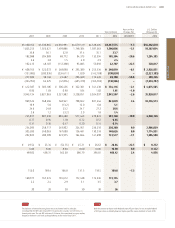Fujitsu 2012 Annual Report Download - page 21
Download and view the complete annual report
Please find page 21 of the 2012 Fujitsu annual report below. You can navigate through the pages in the report by either clicking on the pages listed below, or by using the keyword search tool below to find specific information within the annual report.
Future challenges and measures
What initiatives do you have planned for growth fields?
We will continue to concentrate investment in cloud services,
big data, and global business operations.
Q.4
A.4
One of Fujitsu’s strengths is an integrated vertical model that begins with services, such as system integration and
cloud services, and extends to products such as supercomputers, servers, and smartphones, as well as to technology,
specifically semiconductors. We meet customer needs by developing this model on a global scale.
Areas where we can further capitalize on the strengths of this integrated vertical model are identified as Fujitsu’s
next growth fields. These are the areas where we will continue to invest. For example, as the paradigm for corpo-
rate ICT systems shifts from an ownership to a user model, customers are gaining a better understanding of con-
cepts like public ? and private ? clouds, and utilizing them more. Fujitsu is investing in cloud computing worldwide,
and has put a structure in place to meet customer needs. Consequently, cloud-related revenue on a non-consoli-
dated basis was 275% higher than our initial projections for the fiscal year ended March 31, 2012.
With the explosive rise in digital data, coupled with improved cost performance for ICT, some customers have
taken steps to put big data to work in ways beneficial to their own corporate management processes.
In the field of big data, Fujitsu has combined the collection, collation and integration of large volumes of sensing
data with new knowledge to create predictive models through real-time and batch processing. We now offer this as
Platform as a Service (PaaS), the world’s first cloud service.
In parallel, we are converting this technology and operational knowhow into systems, which we offer as easy-to-
use software products. For Fujitsu corporate customers looking to utilize big data, we are consolidating our system
development expertise and technologies to offer on-premise system solutions.
This kind of new and highly sophisticated ICT utilization may prove useful for discovering new approaches to previ-
ously intractable social issues, while bringing greater abundance to people’s lives. I hope to see ICT become even
more useful in these ways. In agriculture, for instance, along with traditional supply chain management for agricul-
tural goods, farm operators are beginning to use sensing data to grow even more delicious produce. Another exam-
ple is in the field of healthcare, where pulse simulations that take advantage of the advanced simulation capacity of
supercomputers are being used to pioneer tailor-made treatments optimized for individual patients. Fujitsu will hone
its own integrated vertical strengths in these areas to unlock this kind of new ICT potential in the years ahead.
Our globalization is a key theme for Fujitsu’s growth vision going forward, and our target is to have overseas sales
account for 40% of net sales. As the global competitive environment heats up, so too do calls for a common frame-
work for sales interaction supporting customers in the same region, along with the provision of competitive products
built on extensive cost efficiency. By putting a globally integrated organization and systems in place, for example, we
intend to support the global expansion aspirations of any and all companies looking to advance beyond their own
shores. To this end, we have set about optimizing the product portfolios of every base, where lineups often varied, to
standardize and enhance our offerings on a global scale. We will also invest in integrating global communications
and other business infrastructure to bolster communication between offshore bases scattered across the globe and
business divisions in Japan. Ultimately, we hope to translate our determination to tie global integration efforts to
Fujitsu’s integrated vertical strengths into a source of competitiveness in the years ahead.
?
Public Cloud
This is a platform providing unspecified users, from individuals to
groups like companies, with access to shared use of servers, storage,
operating systems, and other IT resources via a network. There is no
need to build an in-house system or to own or manage IT assets onsite.
Glossary
Private Cloud
Whereas public clouds offer shared use by unspecified users, private
clouds are platforms created for specific users. The idea behind
private clouds is to reduce IT costs by having user groups like group
companies and departments share IT resources instead of providing
them for each individual entity.
019
FUJITSU LIMITED ANNUAL REPORT 2012
Management
























